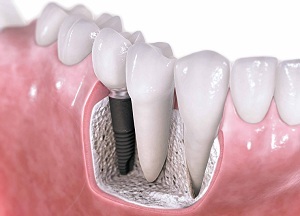 A tooth, susceptible to a disease and not receiving treatment, begins to deteriorate. If the damage is extensive, installing the seal will not help, but you can restore the tooth with a pin.
A tooth, susceptible to a disease and not receiving treatment, begins to deteriorate. If the damage is extensive, installing the seal will not help, but you can restore the tooth with a pin.
Some patients scare this technology, mainly because of not very aesthetic photos of the installation process itself. In fact, there is nothing terrible in this procedure, if you understand more.
Contents
- Design and function
- Indications and contraindications for the
- installation Types of
- pins What should be considered when choosing a support rod?
- Preparing for
- installation
- installation process Rehabilitation and recovery after
- procedure Possible problems
- Asked - we answer
- Similar solutions
- Word to patients
- Especially not impoverished. ..
Design and function
The pin is a rod made of strong material that is installed directly into the root canaltooth. It is a support that helps to maintain your own tooth root and do without its removal.
Both removable and non-removable dentures can be installed on the pin, as well as restorative materials. There are factory designs and made on an individual impression for an individual patient.
The installation of the rod is necessary not only to preserve the natural tooth root, but also to ensure that the dentition is not deformed, and the jaw does not lose its original contour.
Indications and contraindications to the
installation In dentistry, the pin setting in the tooth is prescribed at the following indications: 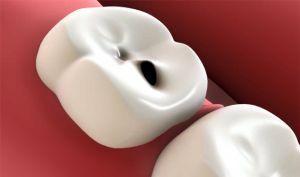
- tooth weakened by a neglected carious disease or pulpitis;
- tooth crown destroyed more than half;
- need to create a support for the subsequent installation of the prosthesis;
- process of implantation, implying the subsequent return of the tooth to the alveolus after removal of the infectious focus.
It is also necessary to comply with two conditions that allow the installation of the rod.
- the root wall should be thicker than 2 mm;
- root canal can be sealed to 2/3 and give it the shape of a cylinder.
As a contraindication, a number of factors distinguish:
- the presence of periodontal inflammation or its damage;
- tooth crown in the frontal part completely absent;
- roots are short and thin, which makes the rod installation impossible;
- presence of granuloma and cyst;
- blood diseases, especially those that affect its coagulation;
- diseases of the nervous system and mental disorders;
- pregnancy.
Most contraindications are somehow associated with other diseases of the oral cavity, so it makes sense to first eliminate all current problems, and then think about restoring the tooth. In the case of pregnancy, surgery can be postponed, well, in other situations it will be necessary to look for a different method of restoration.
Types of pins
Support rods differ in the manner of their fixation, the composition of the product and the form. Depending on the material, the following types of pins for teeth are distinguished:
- Anchor is made from an alloy of gold and platinum or palladium. Variants of a lower price category suggest the use of
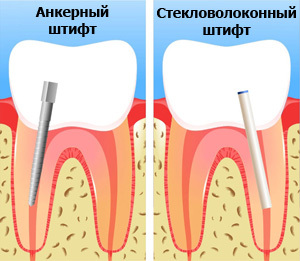 stainless steel, brass, titanium. Such a pin can have two fixing methods. On the body of the active rod is made a special thread, thanks to which the pin is screwed into the channel. The method has drawbacks - it can lead to the destruction of the tooth during the installation, so it is used only in those cases where a full restoration of the crown is required. Installation passive type occurs with the help of medical cement. This method is used if the tooth has not yet collapsed to the end.
stainless steel, brass, titanium. Such a pin can have two fixing methods. On the body of the active rod is made a special thread, thanks to which the pin is screwed into the channel. The method has drawbacks - it can lead to the destruction of the tooth during the installation, so it is used only in those cases where a full restoration of the crown is required. Installation passive type occurs with the help of medical cement. This method is used if the tooth has not yet collapsed to the end. - Fiberglass rods are a relatively recent discovery that allows you to make pins that are hypoallergenic. This is an appropriate option for patients who are allergic to any metal. Also, these products are made more lighter and more elastic, give less stress on the root and can be installed in one visit. If necessary, the rod can be removed without problems.
- Carbon are made of carbon fiber and are the most aesthetic and durable. With such a design, the risk of a root fracture is practically absent.
- Parapulpic view is a metal structure coated with a polymer mass and is used for additional support.
- The cultured tab is a microprosthesis that can help even when the tooth is completely destroyed. On top of such a design is covered with a crown. It is made by individual casts, taking into account the relief of a particular tooth root, so for some time you will have to wait until the tab is ready.
How to seal the channels of the front tooth using a gutta-percha pin:
There are several forms of rods:
- standard and the most common variant is the conical and cylindrical ;
- also possible combination - cylinder cone ;
- in addition, there is still helical variety .
What should I consider when choosing a support rod?
Usually, the appointment of a certain type of rod is made by a specialist, but in the process of choosing it can take into account the patient's financial capabilities and any individual wishes. 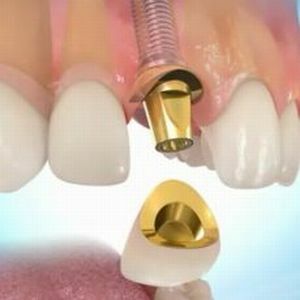
However, the main factor determining the conditions of choice is the state of the tooth:
- , it is necessary to take into account the thickness of the root walls, its length and the overall degree of destruction;
- the level of location of the affected site relative to the position of the gum;
- the role of the tooth and the load on it - whether it is standing alone or enters a supporting structure for installing a bridge prosthesis.
It is also important to take into account the patient's health and the presence of allergies to him or her on metals or other materials.
Preparing for installation of
Before performing the procedure itself, the patient is assigned a comprehensive examination of the oral cavity for lack of contraindications, and also to determine if it is possible to install the pin in this case.
The optimal material is selected. If necessary, sanitation is performed.
Installation process of
After the decision to complete the procedure and all the preparatory stages has been made, the installation begins:
- is being ground and pulped - nerve removal in the damaged tooth ;
- pin is installed directly into the cleared channel ;
- natural outward appearance of the tooth restore .
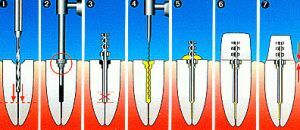 Despite the fact that the pins look quite intimidating, the operation is not painful, since the nerve is previously removed, which means that there is already nothing to hurt.
Despite the fact that the pins look quite intimidating, the operation is not painful, since the nerve is previously removed, which means that there is already nothing to hurt.
The patient is more likely to experience psychological discomfort than real pain.
Rehabilitation and recovery after
procedure In order for the rehabilitation process to proceed normally and without complications, it is necessary to follow the prescriptions of the doctor and observe all the prescriptions:
- Take medicine and follow a special diet of , using soft and mashed or liquid food that will not injure the mucous membrane.
- Do not forget about the hygiene of by brushing your teeth at least twice a day, while doing this carefully so as not to irritate the gums.
- You can not use toothpicks, it's better to replace them with dental floss.
- Strong load on the teeth of is not permissible, it is forbidden to crack shells of seeds or nuts.
- You have to go to the dentist's on time, at least every six months, and if you have any problems, contact your doctor at the earliest opportunity.
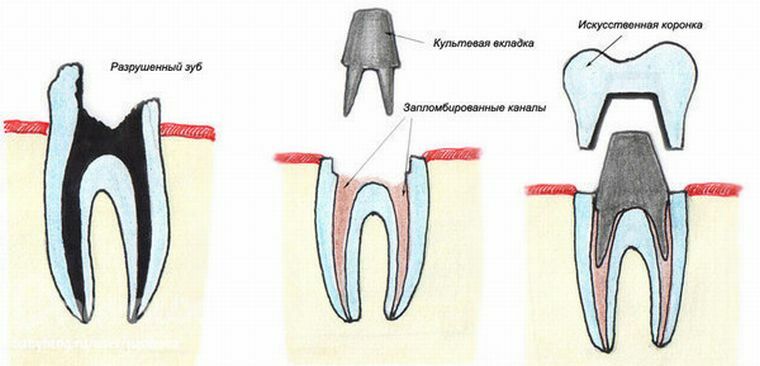
Schematically shows how to put the stump tab
Possible problems
After the procedure, there may be some complications:
- pain at the place of restoration and next to it;
- periodontitis;
- swelling of the gums;
- inflammation of tissues.
Asked - Answer
Frequently Asked Questions About Pins:
- Does it hurt? No, because the nerve is removed before the installation, which means there will be no pain.
- Why, despite the removal of the nerve, does pain arise after the installation? Perhaps this is just a short-term pain after removal of the nerve, which will soon pass itself. Also, painful sensations may indicate an allergic reaction or that the pin has penetrated too far into the root. If the sensations do not go away and build up - always consult a doctor.
- What if the pin breaks? It is necessary to apply to the clinic as soon as possible, so that the specialist takes appropriate measures. Independently this problem can not be solved.
- What if the broken tooth with the pin was accidentally swallowed? Consult a surgeon who will prescribe an X-ray to detect a foreign body in the body and make a further decision.
Similar solutions
If the standard support rods are not suitable for some reason, you can pay attention to their analogues:
- Molded cult inserts are a monolithic construction made of one material. Currently, few are used, since the pins have practically displaced them.
- The creation of the stump is possible without the use of pins.
- Demountable structures , created by individual order. Usually they are put on badly damaged teeth.
- Individual pins , which can be fixed even in almost hopeless roots.
The word to patients
Customers who have already used the installation of dental pins, express their opinion and share their impressions in their responses.
Six months ago I had pins on two front teeth. After that, a little pain was felt in the first days after the installation, but then it went away, and the teeth do not bother.
Anna
It's been ten years since I installed the pins. Everything is fine, nothing hurts and does not interfere. True, the color of the teeth changed a little four years ago.
Sergey
We put titanium pins under the crowns eight years ago. There were no problems, at first it was uncomfortable and slightly uncomfortable, but then I got used to it.
Elena
The doctor put a pin with a photopolymer seal about three months ago. The seal was cut so that it did not interfere with the mouth. For some time after installation, a metallic taste was felt periodically.
Constantine
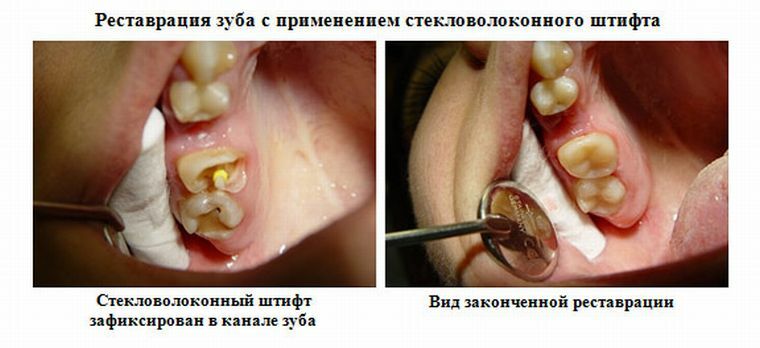
Especially not impoverished. ..
The installation price depends mainly on the material of the rod, as well as whether the structure is dismountable or monolithic, whether the pin refers to the factory pin or is made to order on the customer's request.
Price of pins:
- metal - from 600 rubles;
- titanium anchor - from 900 rubles;
- fiberglass - from 1000 rubles;
- if the pin is made on an individual rod, an extra charge of 300 rubles is added;
- rod extraction from the channel - from 900 rubles.
 If dentists have prescribed a pin, and the patient has no contraindications to this procedure, it will help preserve the root of the tooth, the chewing function and the natural contours of the jaw, so it is better to agree to surgery.
If dentists have prescribed a pin, and the patient has no contraindications to this procedure, it will help preserve the root of the tooth, the chewing function and the natural contours of the jaw, so it is better to agree to surgery.
In addition, this method is cheaper than prosthetics. It is better to be mentally adjusted in advance, convincing yourself that there will be no pain, as the nerve will be removed before the rod is inserted.
Then the patient is not nervous and does not feel any discomfort, the process will be more relaxed. After everything is over, do not forget to follow the doctor's recommendations during the rehabilitation period, and also carefully monitor the condition of the oral cavity in the future, so as to preserve the health and integrity of the teeth as long as possible.
